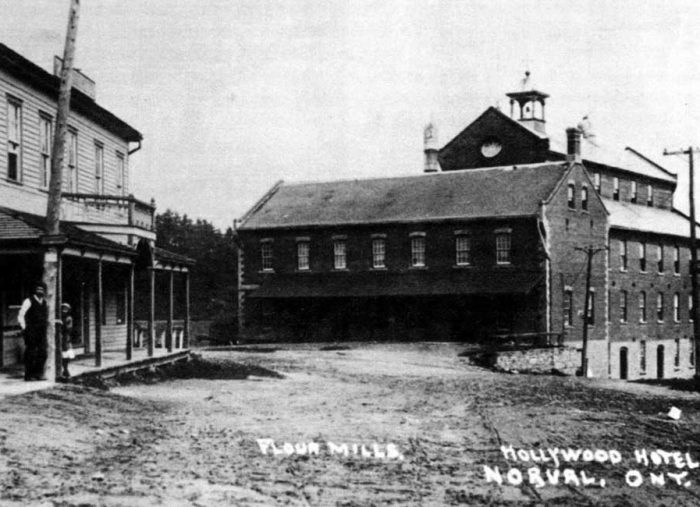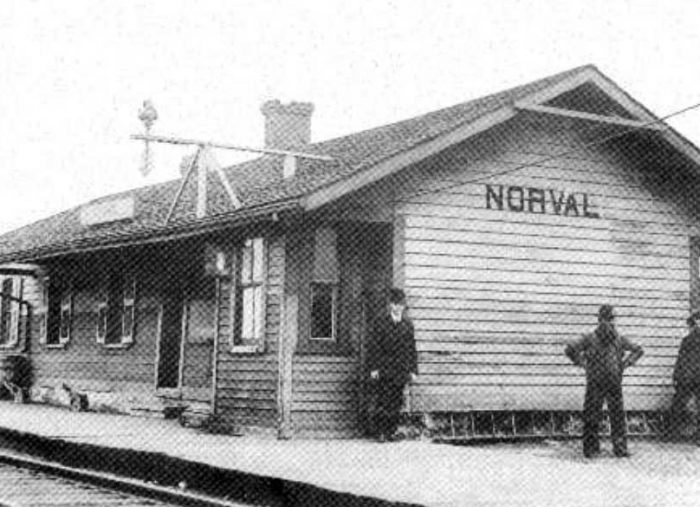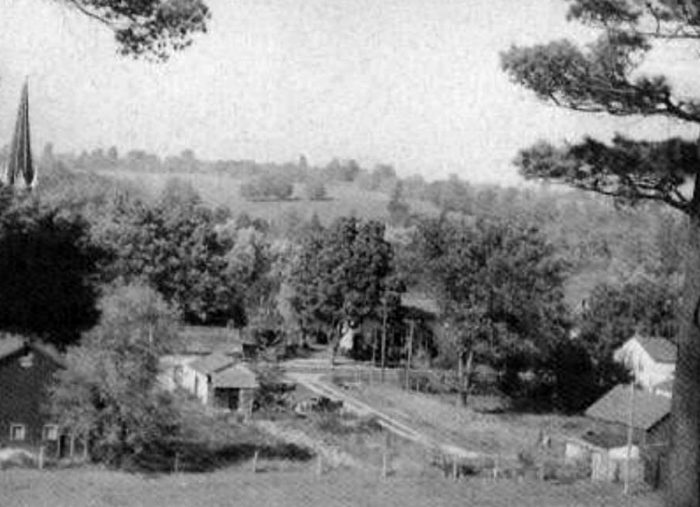The modern history of Norval begins on the 28th October, 1818. In Toronto Township the Chiefs of the Otter and Eagle Tribes, “Principal Men of the Mississauga Nation” put their totems on “Treaty 19”; and agreement to buy a large tract of land in the Home District. Lieutenant Governor Maitland named two of the townships, Chinguacousy and Esquesing, names used by the Mississauga Indians; Norval is in both townships.
The earliest settler, Loyalist Alexander McNab and family, arrived about 1820.
Alexander raised sheep on the hills, to the east of the village.
James McNab, brother of Alexander, was a Lieutenant in the York Volunteers, and fought the Americans in the War of 1812.
James built a grist and saw mills on the Credit River. Oak for barrel staves, and great timbers of white pine, masts for the British navy, were floated down the river.
In 1827, James advertised his “Esquesing Mills” in Mackenzie’s Colonial Advocate, offering free land grants to tradesmen.
The mills were sold to General Peter Adamson in 1838. He leased them to Gooderham and Company. James Worts ran the distillery and the mill.
Colonel Mitchell, a son-in-law of General Adamson bought the mills, but later the Bank of Ontario seized them.
Robert Noble bought them in 1868 and built new brick mills. The flour mill could produce over 200 barrels a day; a nearby cooper shop made the barrels. The flour mill burned in 1930; the grist mill was destroyed in Hurricane Hazel.
The village had blacksmith and harness shops, carriage works, woollen and flax mills, broom factory, ashery, bakery, brass foundry, general stores, Orange Lodge, Mechanic’s Institute, and several hotels; Norval was a main stagecoach stop from Toronto to Guelph.
The Presbyterian Church had the first congregation, and built a frame church beside the cemetery;it was replaced by a fine gothic church in 1868.
The Methodist built a church in 1850 and replaced it with a brick one in 1889.
The Anglican Church, built in 1846, is the original building.
By 1846, the settlement had a population of around 200 people.
Norval Post Office was established in 1836 (earlier names, McNabsville or McNab’s Mill). Tradition says the name came from the Scottish play “Douglas”, by John Home. “My name is Norval; on the Grampian Hills.”
Colonel William Clay was the first postmaster and had the job for over 50 years.
Three generations, William, Everett and Hardy Barnhill, were postmasters from 1897 to 1957.
The Post Office closed in 1990 and became a retail postal outlet; the last Postmaster was Joan Carter.
The first school was a frame building near the cemetery. By the 186o’s a brick school had been erected in the village, and a second room in 1873. The school closed in 1974.
Norval had it’s own militia company and drill shed.
The only action they had was a trip to the Welland Canal, to protect it from an invasion of Fenians from the United States. By the time they arrived the Fenians had gone home. A picnic and dance were held when they returned and the Queen was cheered. After World War I, villagers met the veterans at the “radial” with flaming torches, and paraded through the village burning straw effigies of the Kaiser in the ditches. Veterans from both world wars were presented with an engraved watch.
The Farmer’s Bank, built in 1907, failed in 1910. Metropolitan Bank purchased the building, later merging with the Bank of Nova Scotia. The branch closed in 1931.
In 1913, Upper Canada College bought 500 acres of land and had plans to move the College from Toronto to Norval, but plans changed. Their outdoor school is there today.
Norval was well-situated for early settlement because of the river.
The Guelph Plank Road was completed in 1851 and Colonel Clay organised a “grand ball” to celebrate. The Grand Trunk Railway (later the CNR) opened in 1856, but Norval Station was over a mile north of the village.
The station closed in 193o’s. A nearby post office, called Norval Station, closed in 1947. The last postmaster was Arthur Morris.
The Toronto-Guelph electric Suburban Railway (radial line) opened in 1917, with a switch into the village to serve the flour mills. The railway closed in 1931.
In the early 192o’s three new bridges were built over the Credit River and the mill races, while the King’s Highway No. 7 was paved. Norval was a village of bridges, at one time there were nine.
Hollywood Hotel and Mill
Some early owners existing houses were: William Gooderham, distiller; Arthur Little, shoemaker(1858); Peter Adamson, mill owner; Robert Hamilton, broom maker; Dr. Samuel Webster, village doctor for over 50 years; George Day, blacksmith; Robert Watson Sr., blacksmith and carriage maker; Robert Watson, baker.
Hollywood hotel built in the late 1840s or early 1850s.
The Norval Flour Mill, built by James McNab in 1828 and later owned by Robert Noble from 1868 to 1920. The grand old Mill burned down in the winter of 1930.
Famous residents:
J.W.L. Forster (1850-1936) 19th century portrait painter of noted Canadians.
Jack Watkins (1902-1964), former Ambassador to Russia.
Lucy Maud Montgomery (1874 – 1942) who lived at the Presbyterian Manse from 1926 to 1935.
—–
Information taken from Norval on the Credit by Rev. Dr. Richard Ruggle for the Esquesing Historical Society
Many thanks to Halton Hills Public Libraries and Joan Carter.
Published in conjunction with the 85th Anniversary of the Norval Women’s Institute, 1991.
ISBN 0-921091-13-5






